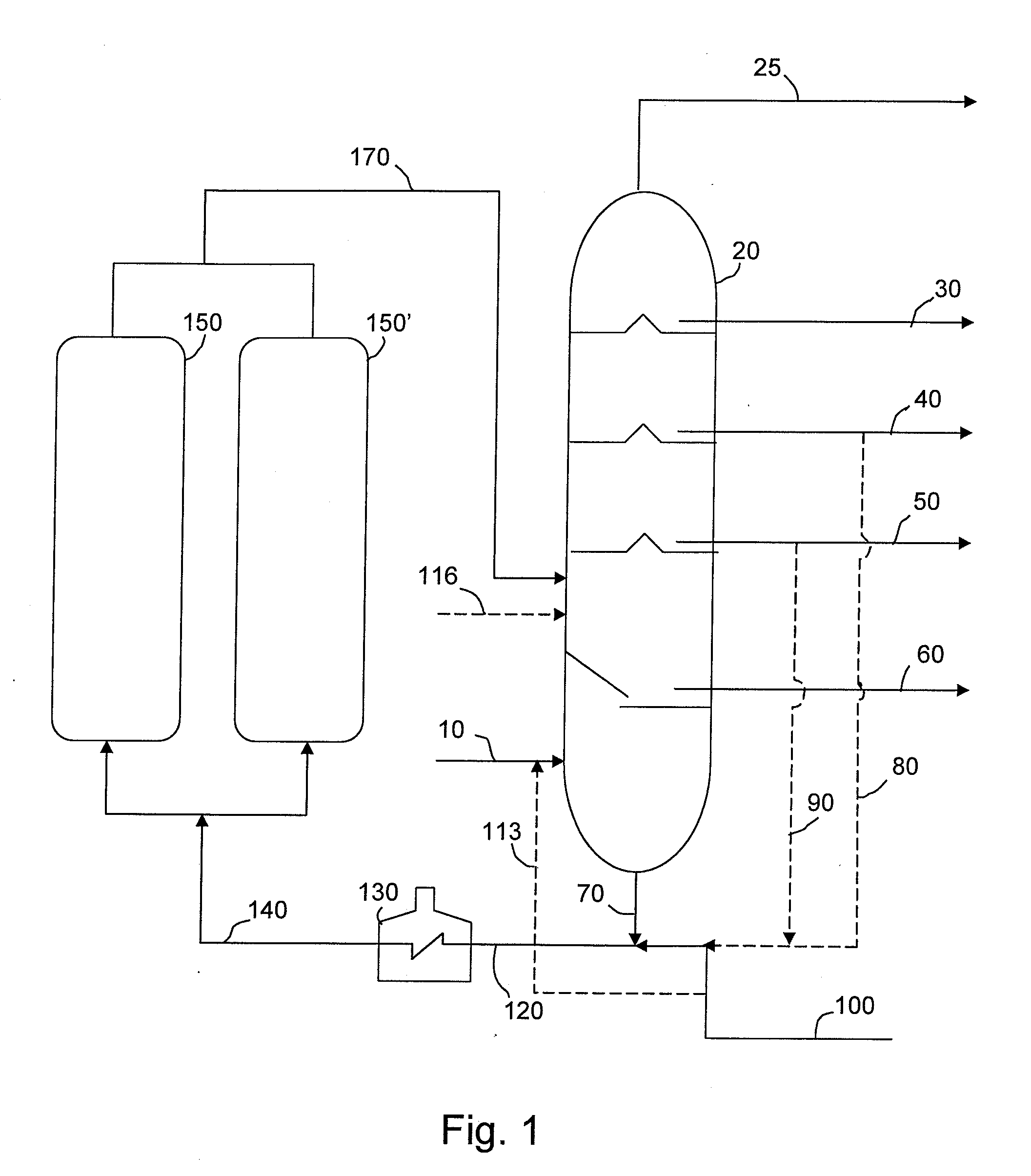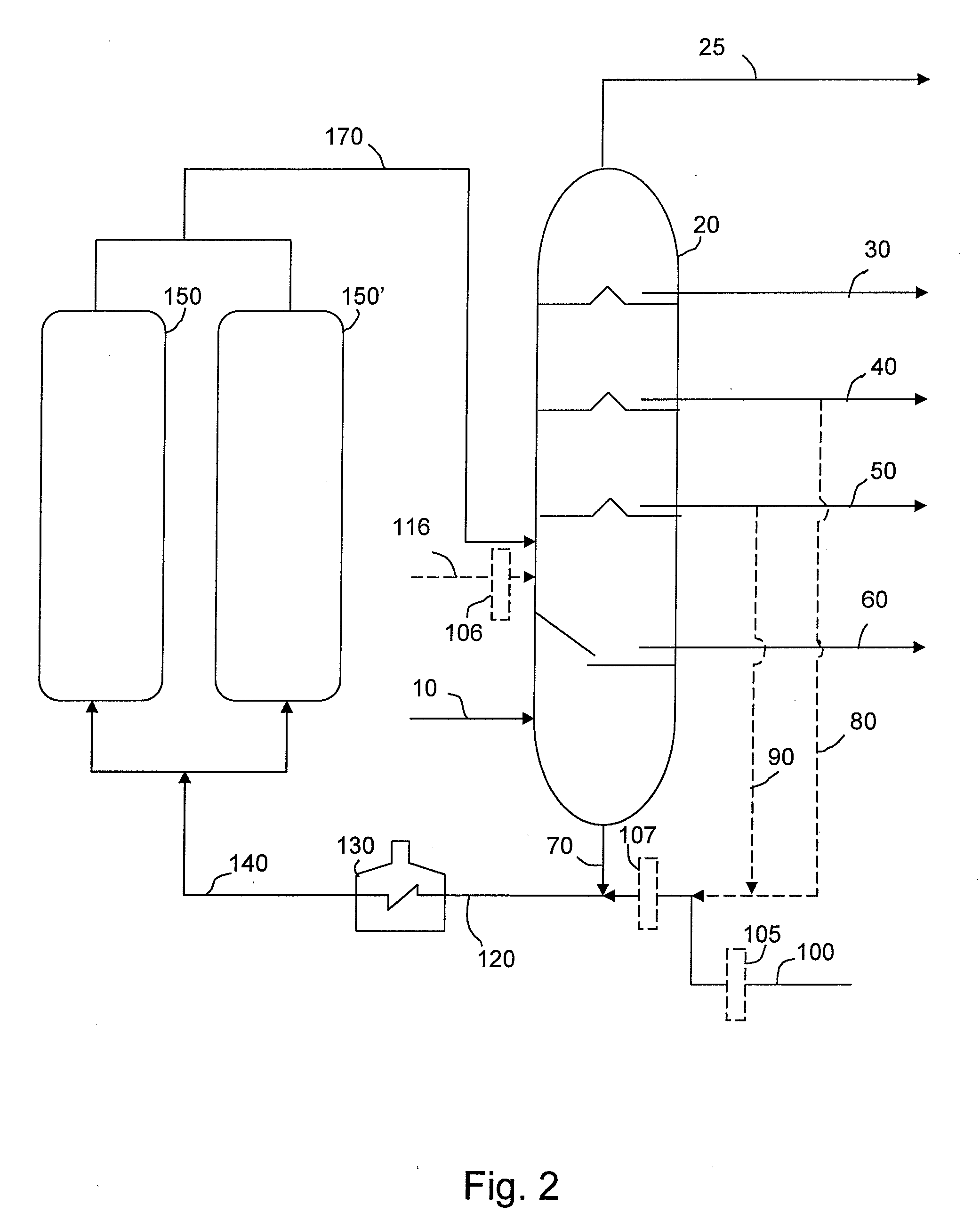Method for Reducing Fouling of Coker Furnaces
a furnace and coker technology, applied in the direction of hydrocarbon oil treatment, corrosion/fouling inhibition of treatment apparatus, cracking process, etc., can solve the problems of furnace decoking, high operating cost, operation must be shut down, etc., to reduce furnace fouling, reduce furnace fouling, and increase the aromaticity of the bottom stream
- Summary
- Abstract
- Description
- Claims
- Application Information
AI Technical Summary
Benefits of technology
Problems solved by technology
Method used
Image
Examples
example 1
[0068]Coking Propensities of Feedstocks Modified with Various Gas Oils
[0069]A resid feedstock having physical properties as shown in Table I was tested using the coking propensity apparatus described in International Publication No. WO 01 / 53813. Also tested were blends consisting of about 80 wt % of the resid with about 20 wt % of each of the gas oils listed below in Table I.
TABLE IGas Oil PropertiesGASOIL #DESCRIPTION1Aromatic needle coker gas oil2Gas oil 1, hydrotreated with a Co / Mo catalyst to givea hydrogen uptake of about 400 SCFB3Gas oil 1, hydrotreated with a Ni / Mo catalyst togive a hydrogen uptake of about 1,000 SCFB4Less aromatic needle coker gas oil, hydrotreated witha Co / Mo catalyst to give a hydrogen uptake of about 370 SCFB5Blend of virgin non-needle coker gas oil and lessaromatic needle coker gas oil, hydrotreated with a Ni / Mocatalyst to give a hydrogen uptake of about 480 SCFB6Flash zone gas oil from a delayed coking operationfor production of fuel coke
[0070]The prope...
example 2
[0073]Coking Propensities of Feedstocks Modified with Fractionated Gas Oils
[0074]Gas oils 1 and 3 were each fractionated to produce a 750-850° F. fraction and an 850+° F. fraction. These fractions were mixed with the resid from Example 1 in a proportion of about 80 wt % resid and about 20 wt % gas oil. The properties and OCFT data for these samples are summarized in Table IV.
TABLE IVCoking Propensity Results (Example 2)RunAvg. LiquidOCFTCorrectedNo.Gas Oil ModifierTemp (° F.)(min)OCFT (min)202None700385236203None756 85204208None735157226AVG:22220416 wt % of 750-850° F.753138309fraction of gas oil #120520 wt % of 850+° F.734187263fraction of gas oil #120620 wt % of 750-850° F.747189365fraction of gas oil #320718.3 wt % of 850+° F.705231160fraction of gas oil #3
[0075]The data in Table IV demonstrate that the 750-850° F. fraction is more effective than the 850+° F. fraction at slowing coke formation, particularly in the case of hydrotreated gas oil #3.
example 3
[0076]Coking Propensities of Feedstocks Modified with Fractionated Gas Oils
[0077]Gas oil 6, which was less effective at slowing coke formation than the other gas oils tested in Example 1, was fractionated to produce a 750-850° F. fraction and a fraction boiling below 950° F. These fractions were mixed with the resid from Example 1 in a proportion of about 80 wt % resid and about 20 wt % gas oil. The properties and OCFT data for these samples are summarized in Table V.
TABLE VCoking Propensity Results (Example 3)RunAvg. LiquidOCFTCorrectedNo.Gas Oil AdditiveTemp (° F.)(min)OCFT (min)213None731162212219None724200243AVG:22721720 wt % of 750-850° F.742139238fraction of gas oil #621820 wt % of 950−° F.737165250fraction of gas oil #6216Gas oil #6731173226
[0078]Table V illustrates results similar to those of Example 2, specifically, that separating out the highest molecular weight fraction of the gas oil makes the gas oil more effective at slowing the onset of coke formation.
PUM
| Property | Measurement | Unit |
|---|---|---|
| boiling point | aaaaa | aaaaa |
| boiling point | aaaaa | aaaaa |
| operating temperature | aaaaa | aaaaa |
Abstract
Description
Claims
Application Information
 Login to View More
Login to View More - R&D
- Intellectual Property
- Life Sciences
- Materials
- Tech Scout
- Unparalleled Data Quality
- Higher Quality Content
- 60% Fewer Hallucinations
Browse by: Latest US Patents, China's latest patents, Technical Efficacy Thesaurus, Application Domain, Technology Topic, Popular Technical Reports.
© 2025 PatSnap. All rights reserved.Legal|Privacy policy|Modern Slavery Act Transparency Statement|Sitemap|About US| Contact US: help@patsnap.com



